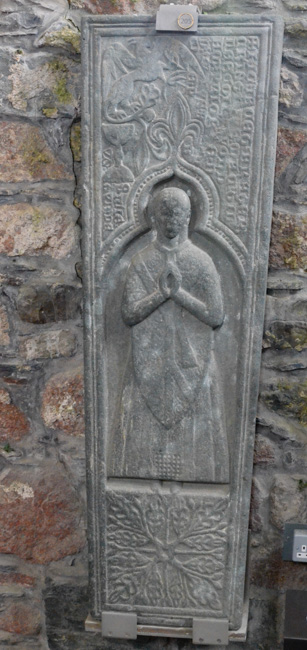Someday I want to participate in an Iona retreat. In the meantime I am glad to have had two short visits. Several of the church leaders in my home church have been to the retreats, and I was happy to be able to say prayers for my pastor and his family while here since he had suffered a heart attack shortly after we left. (By the time we got home, he was doing fine.)

Iona is served by a ferry from the nearby island of Mull. Our Zodiacs came in alongside the ferry landing right in the village center of Baile Mor.

The nunnery was founded in the 13th century and fell into ruin after the dissolution of the monasteries during the reign of Henry VIII.
 Stones & flowers in the garden wall.
Stones & flowers in the garden wall.

Archeologists were at work in several places around the island. I think these mappers are using a magnetometer, which can identify elements such as ditches and pits. They proceeded across the field in a precise pattern. We saw similar instruments and procedures at St. Andrews.

The original monastery on Iona was founded in the 6th century by Columcille, better known as St. Columba, when he was exiled from Ireland.
St. Martin's cross is one of the best preserved Celtic crosses in the British Isles. It dates from the 9th century. The original cross is in the museum; this is a replica set on the original base in front of the abbey.
After repeated Viking attacks many of the monks relocated to Kells in Ireland. Portions of the Book of Kells may have been created on Iona prior to the move.

The current abbey church dates in part from the 14th century. It was abandoned in the 16th century and restored at the end of the 19th. Additional restoration work was underway during our visit.
The small chapel behind the cross is the traditional site of St. Columba's burial. The hill where I'm standing to take this picture is the traditional site of his cell, which would have been beehive-shaped like the ones on Skellig St. Michael.

Many old tombstones had been removed from the cemetery and brought inside for their protection.
The Scottish king MacBeth is said to be buried here. (The Shakespeare play bearing his name has little resemblance to the actual history.)

A short way from the abbey I found the Fallen Christ sculpture depicting Christ on the way to Calvary almost crushed by the weight of the cross. More on the iconography can be found at the link.

On my way back to the landing I wandered into the parish church, where I found this young man making some recordings of his fiddle tunes. We talked briefly about my own love of Scottish music. Someday I hope to be proficient enough to travel through the area and join in jams.
That evening we had a lecture describing the history and archaeology of St Kilda, our next stop. Although the lecture provided context for our stop there, I would rather have had it afterwards. I think I would have remembered more after seeing that desolate island.
Click your "back" button to return to the previous page or click for our picture album.